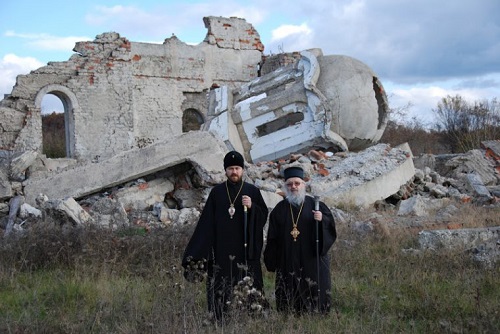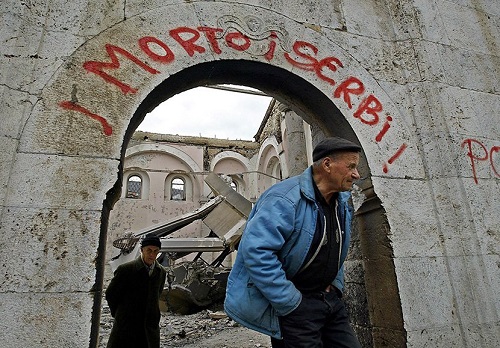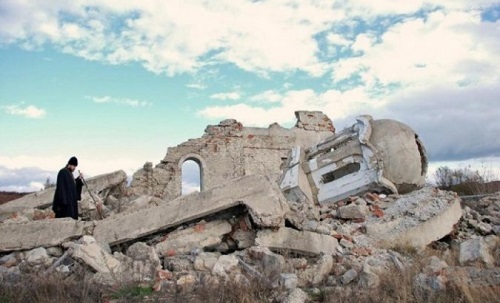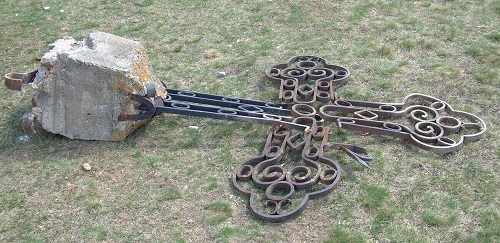Die Folgen des Wütens albanischer Extremisten in Kosovo am 17. und 18. März 2004 sind erschreckend – etwa 30 Menschen wurden getötet und über 950 Personen verwundet und verletzt (einschließlich etwa 100 Soldaten der internationalen Truppen und Polizisten), 35 orthodoxe Kirchen wurden niedergerissen und 935 serbische Häuser zerstört und ausgebrannt, mehr als 4.000 Serben und andere Nicht-Albaner wurden vertrieben. Sechs Städte und neun Dörfer wurden ethnisch gesäubert.
Unschätzbares serbisches Kulturerbe, tausende Ikonen, Fresken und andere Kirchenreliquien, alte und seltene Bücher und Dokumente verschwanden während des März-Pogroms oder wurden zerstört und beschädigt.
Eine bösartig und falsch interpretierte Meldung über das Ertrinken eines albanischen Kindes, wofür die Schuld den Serben unbegründet zugeschrieben wurde, wurde ohne Überprüfung, jedoch hysterisch und in Böser Absicht von albanischen Medien weiterverbreitet. Das löste vor neun Jahren in Kosovo und Metochien ein zweitätiges Pogrom gegen die serbische und Nicht-Albanische Bevölkerung aus, dessen Folgen leider auch bis heute zu spüren sind. Die Zahl der albanischen Extremisten, die sich vor dem Gericht verantworten mussten und verurteilt wurden, ist nicht einmal symbolisch, wenn man Schätzungen berücksichtigt, dass am Pogrom etwa 50.000 Albaner teilgenommen hatten.
Vertreter der internationalen Gemeinschaft schätzen damals ein, dass „die ethnisch motivierte Gewalt gegen die Serben im Kosovo geplant und gut orchestriert war“. In der OSZE-Analyse der damaligen Berichterstattung albanischer elektronischer und Printmedien wurde festgestellt: „Ohne eine derartige rücksichtslose und sensationslüsterne Berichterstattung hätten die Ereignisse eine andere Wendung nehmen können. Sie hätten vielleicht nicht dieses Ausmaß und dieses Niveau an Brutalität erreicht, das bezeugt wurde, oder sie hätten vielleicht auch gar nicht stattgefunden.“
Die begangenen Verbrechen dürfen weder unbestraft bleiben noch vergessen werden, wie auch die traurige Tatsache nicht vergessen werden darf, dass seit Juni 1999 vor den Augen der internationalen Öffentlichkeit und auch mehrerer tausend KFOR-Angehörigen 240.000 Serben, Montenegriner, Kroaten, Roma, Juden und andere Nicht-Albaner aus Kosovo und Metochien vertrieben wurden, von denen gewiss die Mehrheit zu ihren jahrhundertealten Heimen in Kosovo zurückkehren möchte. Priština und viele andere Städte und Siedlungen in Kosovo und Metochien sind inzwischen ethnisch gesäubert, mehr als 155 serbische Kirchen, Klöster, Friedhöfe wurden zerstört und geschändet und tausende Häuser und Wohnungen wurden widerrechtlich besetzt.
Die Rückkehr der vertriebenen Menschen und ein Leben in Sicherheit, die Aufklärung des Schicksals der vermissten und getöteten Menschen sowie eine effiziente Ermittlung über illegalen Organhandel in Kosovo ist eine Verpflichtung der internationalen Akteure, damit die Mörder und Verbrecher nicht unbestraft bleiben und damit Pogrome und ethnische Säuberungen nie wiederholt werden.
Film: Crime without punishment / Schuld ohne Sühne




Pogrom against Serbs in Kosovo in 2004: Oppression without punishment!
March 12, 2021. Source: Frankfurt News / News Online
By lighting candles and paying tribute to the victims, these days Serbia remembers the Pogrom of Serbs from Kosovo and Metohija, which occurred on 17th and 18th of March 2004 - as the first ethnic cleansing in the 21st century.
The Pogrom was a consequence and epilog of the NATO-Aggression and bombing under violation of international law of the FRY on 24th March 1999.
The exodus of Serbs in front of KFOR and UNMIK, which legally and formally controlled Kosovo and Metohija, began on March 17, 2004, and in the next few days, 28 people were killed, 4,000 civilians were expelled and more than 900 burned. Houses and dozens of Orthodox shrines, most of which were under UNESCO protection or medieval heritage.
In the topic of the issue, "Vesti" reminds what happened 17 years ago, but also investigates what has been done in the meantime in order to improve the position of the non-Albanian community in Kosmet at least a little. Our interlocutors are unanimous in the assessment that on March 2004, the planet was silent about the first ethnic cleansing in the 21st century.
A writer and journalist from Kosovo who saw this horror with his own eyes, Zivojin Rakocevic estimates that it is "the biggest and most systematic crime in the era of peace in Europe after the Second World War".
- In front of the eyes of about 40,000 foreign soldiers, police officers and officials, an authentic culture was systematically and heartily affected, and above all, the life of Serbs in Kosovo and Metohija. There is not a single segment that was not fatally affected: architecture, fresco painting, libraries, cemeteries, houses and apartments, schools and life itself are still feeling the consequences of the pogrom - Rakočević points out.
Experts from the Office for Kosovo and Metohija of the Government of Serbia agree with this assessment. Igor Popović, Assistant Director of the Office in charge of legal protection, support to local self-government and property and legal affairs, estimates that on that date in Kosovo there was a "strategic destruction" of everything that had the prefix Serbian.
- According to the UNHCR, a total of almost 6,000 residential buildings were destroyed, of which 935 were completely destroyed, while other buildings were damaged. The value of the destroyed private property, according to the estimates of the former Coordination Center, is measured in the value of several tens of millions of euros. In this pogrom, six cities were ethnically cleansed. Pristina, Obilic, Fushë Kosovë, Lipjan, Gjilan and Prizren, as well as nine villages in Kosovo and Metohija, were left without Serbs. In those few days, more than 4,012 Serbs, Roma, Ashkali and Egyptians were displaced - says Igor Popović.
Dr. Dusan Jovovic, assistant director in charge of cultural heritage and cooperation with the Serbian Orthodox Church, estimates that it was not enough for Albanian extremists in 2004 to destroy only civilian property, but they destroyed or damaged 40 churches and monasteries, half of which are protected cultural monuments:
- Among these shrines of the Serbian Orthodox Church that were targeted by the attackers were the Devic Monastery, the Monastery of the Holy Archangels in Prizren, the Church of Our Lady of Ljeviska and the Church of St. George in Prizren, the Church of the Assumption of the Blessed Virgin in Gjakova, the monastery church of Saints Cosmas and Damjana in Zočište… Unfortunately, church property and ritual objects were also targeted by the savage attack. More than ten thousand frescoes, icons, buttercups, clothes, as well as church books of marriages and baptisms have disappeared or been destroyed.
Broken table of honor
Dr. Jovović reminds that the Church of the Mother of God of Ljeviska in Prizren was set on fire from the inside while it was guarded by a special KFOR detachment while it was surrounded by wire.
- The church was set on fire, the altar area was desecrated, and the Holy Table was smashed. Her invaluable fresco is damaged in a mindless arson. They brought in burning tires in order to do as much damage as possible to the frescoes, among which are frescoes from the 13th century. I am proud that the Office for Kosovo and Metohija, headed by the director Dr. Petro Petković, initiated a large project of complete renovation of this shrine of ours. The Office for Kosovo and Metohija is leading this important project, and in cooperation with the Republic Institute for the Protection of Cultural Monuments and the Ministry of Culture and Information…
Renewal in progress
Since the arrival of international forces in 1999, about 135 churches, monasteries and other buildings of the Serbian Orthodox Church have been devastated or destroyed on the territory of the Autonomous Province of Kosovo and Metohija, notes Dr. Jovović.
- So far, thanks to the funds of the Government of RS, more than half of the damaged sacral buildings have been partially or completely renovated, among which the projects for the renovation of the Devic and Zociste monasteries, the seminary and the Cathedral of St. George in Prizren. While giving this interview, we are working on seven capital renovation projects in cooperation and with the blessing of the Dioceses of Raska-Prizren and Kosovo-Metohija.